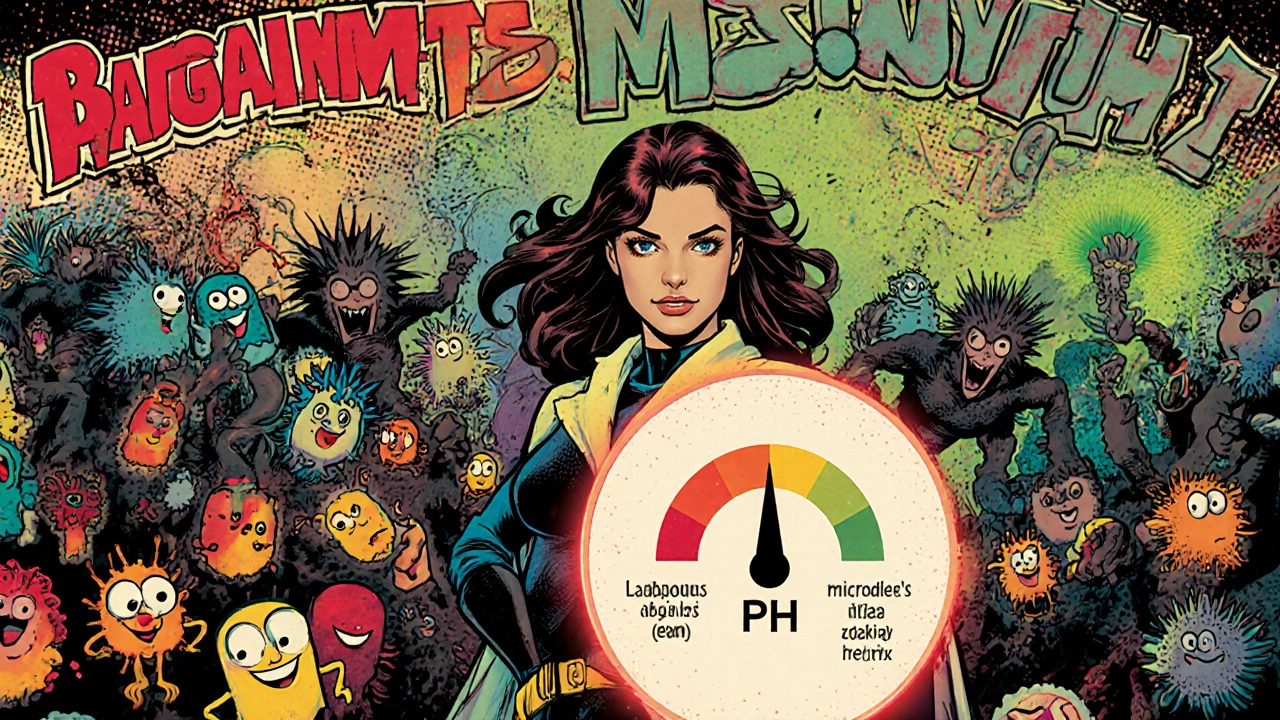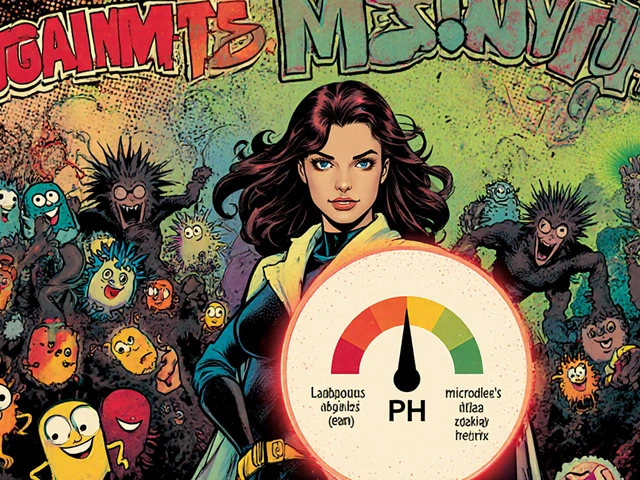BV Remedy Effectiveness Estimator
Personalized Remedy Assessment
Select your symptoms and health considerations to see which natural remedies match your situation best.
When you hear bacterial vaginosis mentioned, the first thought might be prescription antibiotics. But a lot of people wonder if there’s a gentler, at‑home way to clear things up. Below we break down the most talked‑about natural options, what the research really says, and how to use them safely.
What is Bacterial Vaginosis?
Bacterial Vaginosis is a common vaginal condition caused by an imbalance in the vaginal microbiome. Instead of the protective Lactobacillus bacteria that keep the pH acidic (around 3.8‑4.5), other anaerobic microbes like Gardnerella vaginalis take over, creating a fishy odor and thin gray discharge.
It’s not a sexually transmitted infection, but it can increase the risk of pelvic infections and affect pregnancy outcomes. The usual medical route is metronidazole or clindamycin, yet many seek alternatives because of side‑effects, recurring infections, or a preference for “natural”.
Why People Turn to Natural Remedies
Natural remedies promise a gentler approach: they aim to restore the healthy bacterial mix and rebalance pH without antibiotics. Some folks also use them as a bridge while waiting for a prescription or to prevent recurrence after a course of meds.
Before you start, remember that “natural” doesn’t automatically mean “safe” or “effective”. The key is to look at clinical evidence, understand how each option works, and know the possible downsides.
Popular Home Remedies and How They’re Supposed to Work
- Yogurt - supplies live probiotic cultures (mainly Lactobacillus) to repopulate the vagina.
- Tea Tree Oil - a strong essential oil with antimicrobial properties, often diluted and applied topically.
- Apple Cider Vinegar - thought to lower vaginal pH and inhibit harmful bacteria.
- Garlic - contains allicin, a compound that can kill a range of microbes.
- Hydrogen Peroxide - a mild antiseptic that may reduce bacterial load when used in a diluted rinse.
- Boric Acid - a weak acid that can restore a normal vaginal environment, often used in capsule form.
Evidence Review for Each Remedy
Yogurt and Probiotic Supplements
Several small RCTs have compared oral or intravaginal probiotic regimens to placebo. A 2022 meta‑analysis of five trials (total n≈350) found a modest increase in cure rates - about 20% higher than placebo when probiotics were taken for at least 30days. The most consistent strain was Lactobacillus rhamnosus GR-1.
Practical tip: Choose plain, unsweetened yogurt with live cultures (look for “active probiotic cultures”). Apply 2-3 tablespoons intravaginally using a sterile applicator, or eat a cup daily for systemic benefit.
Tea Tree Oil
In‑vitro studies show tea tree oil can inhibit Gardnerella vaginalis and Candida. However, human data are scarce. One pilot study (n=30) used a 0.5% tea tree oil gel for 2weeks and reported symptom relief in 60% of participants, but also noted mild irritation in 15%.
If you try it, dilute at least 1part oil to 10parts carrier (like coconut oil), and do a skin patch test first.
Apple Cider Vinegar (ACV)
ACV’s acidic nature can help maintain a low vaginal pH, theoretically discouraging overgrowth of BV‑associated bacteria. A 2021 case series of 12 women using a 1:3 ACV‑water rinse daily reported symptom improvement, but there was no control group.
Use a gentle mixture (½ cup ACV in 2cups warm water) and rinse for a few minutes, then pat dry. Avoid high concentrations - they can cause burning.
Garlic
Allicin has broad antimicrobial activity. A double‑blind trial (n=44) found that a vaginal capsule containing crushed garlic (300mg allicin) taken nightly for 7days reduced BV recurrence by 30% compared with placebo.
Garlic capsules are available, but raw minced garlic can be irritating; if you use it, wrap the cloves in gauze and apply for no longer than 30minutes.
Hydrogen Peroxide
Low‑concentration (3%) hydrogen peroxide has been used as a short‑term rinse. A 2019 small trial showed a temporary reduction in bacterial load, but the effect vanished after 48hours. Over‑use can disrupt the healthy lactobacilli and cause dryness.
Limit use to once per week, a 5‑minute rinse, then rinse again with plain water.
Boric Acid
Boric acid is the only natural remedy with relatively strong clinical support. A 2020 randomized study (n=80) compared boric acid capsules (600mg) inserted nightly for 14days to metronidazole. Cure rates were 73% vs. 68%, and patients reported fewer side‑effects.
Use only pharmaceutical‑grade boric acid, and never exceed the recommended dose. It’s contraindicated in pregnancy.
Safety, Side‑Effects, and When to Seek Medical Care
Most of these remedies are low‑risk when used correctly, but irritation, allergic reactions, and pH swings can occur. Here’s a quick risk snapshot:
- Yogurt/Probiotics: Generally safe; rare cases of yeast overgrowth.
- Tea Tree Oil: Skin irritation, burning; avoid if you have a known oil allergy.
- Apple Cider Vinegar: May cause stinging; dilute properly.
- Garlic: Strong odor, possible local irritation.
- Hydrogen Peroxide: Over‑drying, disruption of good bacteria.
- Boric Acid: Toxic if ingested; avoid during pregnancy.
If symptoms persist beyond 2weeks, worsen, or you develop fever, pelvic pain, or unusual discharge, see a clinician. Persistent BV can lead to complications, so professional evaluation is key.
How to Choose & Use a Natural Remedy Safely
- Identify your main goal - quick symptom relief or long‑term recurrence prevention.
- Check for any allergies (e.g., essential oils, garlic).
- Start with the mildest option (plain yogurt or a probiotic supplement).
- Track symptoms daily in a simple log - note discharge, odor, itching, and any irritation.
- If no improvement after 7‑10days, either increase the intensity (e.g., add tea tree oil) or consult a healthcare provider.
- Never combine multiple acidic agents (like ACV + boric acid) without professional guidance.
Remember, consistency matters. A single dose of yogurt won’t reset the microbiome; a 30‑day course is more realistic.
Quick Checklist - Natural BV Management
- ✔ Use unsweetened yogurt with live cultures daily OR a probiotic supplement containing Lactobacillus rhamnosus.
- ✔ If irritation is present, avoid acidic rinses until it subsides.
- ✔ Dilute tea tree oil (1%-2%) and patch‑test before vaginal use.
- ✔ Limit hydrogen peroxide rinses to once a week.
- ✔ Consider boric acid capsules only after a doctor confirms you’re not pregnant.
- ✔ Keep a symptom diary and stop any remedy that causes burning or worsening discharge.
Frequently Asked Questions
Can I cure BV with yogurt alone?
Yogurt can help restore healthy lactobacilli, but studies show it works best as an adjunct to medical therapy. For mild, first‑time cases, a 30‑day daily regimen may clear symptoms, yet many women still need antibiotics for full eradication.
Is tea tree oil safe for the vagina?
When heavily diluted (≤0.5% in a carrier oil) and used short‑term, tea tree oil is generally safe for most people. Always do a skin patch test first and stop if you feel burning.
How does apple cider vinegar affect vaginal pH?
ACV is acidic (pH≈3). A diluted rinse can lower vaginal pH temporarily, creating an environment that discourages BV‑associated bacteria. The effect is short‑lived, so it’s useful mainly for symptom flare‑ups.
Can boric acid cause pregnancy problems?
Boric acid is contraindicated during pregnancy because it can be toxic to the developing fetus. Women who are pregnant or trying to conceive should avoid it and discuss other options with their provider.
How long should I try a natural remedy before seeing a doctor?
If symptoms don’t improve within 7‑10days, or if they worsen (e.g., increased pain or fever), schedule a medical appointment. Early treatment reduces the risk of complications.








Richard O'Callaghan
October 17, 2025 AT 02:02I gotta say, the whole "natural" hype can be a bit overblown – I mean, sure, yogurt looks safe but if you mis-handle it you could getting a infection. Also, watch out for those home recipes that say "use 1 cup of acv" – that can cause a serious burn if you dont dilute it properly. My best tip? Start with plain probiotic capsules, they’re easier to dose and you avoid the mess of intravaginal yoggurt. And always use a sterile applicator – don’t just shove a spoon in there, that’s a recipe for disaster. Finally, keep an eye on any itching or burning – if it gets worse, see a doc ASAP.
Alexis Howard
October 18, 2025 AT 05:48Sounds like a marketing gimmick to me
Steve Holmes
October 19, 2025 AT 09:35Wow, what a thorough rundown! I love that you broke down each remedy, especially the part about Lactobacillus rhamnosus – that strain really seems to be the star of the show. The way you explained the dosage for probiotics (2‑3 tbsp intravaginally or a cup daily) is super helpful, and the safety notes are spot on. Also, the reminder to do a patch test for tea‑tree oil is crucial; many people skip that and end up with irritation. Kudos for the practical tips and the clear, step‑by‑step guide – it makes the whole thing feel doable, even for beginners!
Tom Green
October 20, 2025 AT 13:22Hey folks, just wanted to add a quick note: when you’re trying any of these at‑home methods, consistency is key. A single dose of yogurt won’t reset your microbiome – think of it like training a muscle, you need a regular routine. Also, keep a simple symptom diary – jot down discharge, odor, and any itching each day. If you notice a pattern of irritation, stop that remedy and consider a medical opinion. And remember, combining acidic agents (like ACV with boric acid) isn’t advisable without guidance. Stay safe and good luck!
Kate Marr
October 21, 2025 AT 17:08🇺🇸 Nothing beats good ol' American common sense when it comes to health. If you’re looking for a natural option, start with plain yogurt – it’s cheap, widely available, and supports our local dairy farmers. Just make sure it has live cultures, and you’re set. 🌿👍
James Falcone
October 22, 2025 AT 20:55Look, folks, the U.S. has the best resources out there – stick to what works and don’t get sidetracked by weird internet hacks. If you’re trying boric acid, make sure it’s pharma‑grade and follow the guidelines, otherwise you’re just asking for trouble.
Frank Diaz
October 24, 2025 AT 00:42From a philosophical standpoint, the pursuit of "natural" remedies reflects a deeper yearning for autonomy over one's body, yet it also reveals the paradox of modern reliance on anecdotal authority. One must weigh the epistemic value of small‑scale trials against the rigorous demands of evidence‑based medicine. In this dialectic, boric acid stands out as a rare bridge between tradition and scientific validation.
Valerie Vanderghote
October 25, 2025 AT 04:28Let me just say, there’s something oddly comforting about the whole ritual of sitting down with a cup of yogurt and thinking you’re doing something proactive for your health, even if the science only shows a modest benefit. First, we have to acknowledge that the vaginal microbiome is an intricate ecosystem, and tossing in a handful of cultures is like planting a single tree in a forest – it’s a start, but not a solution. Second, the fear of antibiotics, while understandable, can sometimes turn into an irrational aversion, making people grab the nearest essential oil without understanding its concentration or potential for irritation. Third, the article correctly points out that tea tree oil, while promising in vitro, still lacks robust clinical data, which means we should be cautious, especially because skin patches can become painful if not properly diluted. Fourth, apple cider vinegar is another classic example of a home remedy that seems logical on the surface – it lowers pH – but the real vagina already maintains a fairly tight pH range, so adding more acid can backfire and cause burning. Fifth, garlic, with its allicin, is celebrated for its antimicrobial properties, yet the scent alone can be a social deterrent, not to mention the risk of localized irritation if applied raw. Sixth, hydrogen peroxide, though a mild antiseptic, is a double‑edged sword; it can wipe out the harmful bacteria but also decimate the protective lactobacilli, leading to a rebound effect. Seventh, boric acid emerges as the lone champion with decent trial data, but its use is contraindicated in pregnancy, so it’s not universally applicable. Eighth, the safety snapshot in the article is useful, but it could have emphasized the importance of a baseline pH test before starting any acidic regimen – a simple pH strip can prevent a lot of misery. Ninth, I think the big takeaway is that consistency trumps intensity; a 30‑day course of probiotics or a steady yogurt routine will likely yield better outcomes than a one‑off vinegar rinse. Tenth, beyond the mechanical aspects, there’s a psychological component – feeling in control of one’s body can alleviate stress, which itself influences microbiome health. Eleventh, tracking symptoms systematically is essential; a small notebook or app can highlight patterns you might otherwise miss. Twelfth, when none of these natural options bring relief within a week or two, seeking professional help isn’t a defeat but a responsible next step. Thirteenth, it’s also worth noting that diet, stress, and even clothing choices can affect vaginal health – high‑sugar diets and tight synthetic underwear can create favorable conditions for dysbiosis. Fourteenth, let’s not forget that each individual’s microbiome is unique, so what works for one person might not work for another. Finally, while the article does a solid job of summarizing the evidence, a deeper dive into the mechanisms – such as how lactobacilli produce bacteriocins that specifically target Gardnerella – would empower readers to make more informed choices.
Michael Dalrymple
October 26, 2025 AT 07:15It’s encouraging to see such a balanced overview. For those who decide to embark on a probiotic regimen, remember to maintain a consistent schedule and monitor any changes. A gradual approach, combined with a healthy diet rich in fiber, can support the restoration of Lactobacillus populations. If irritation occurs, step back, reassess, and consider consulting a healthcare professional. Persistence and patience are key to achieving lasting improvement.
Kevin Adams
October 27, 2025 AT 11:02OMG the drama of trying to cure BV with home remedies is like a tragic opera! The stakes are high, the emotions run wild, and every tiny symptom feels like a cliffhanger. Yet, amid the chaos, we discover that boric acid-yes, the humble powder-has the power to rewrite the ending. Will YOU survive the acid test or succumb to the endless cycle? Only time-and a steady hand-will tell!!
Katie Henry
October 28, 2025 AT 14:48Esteemed readers, it is with utmost enthusiasm that I commend your dedication to exploring natural avenues for health. The disciplined application of probiotic therapy, combined with vigilant self‑monitoring, exemplifies a commendable commitment to personal well‑being. Persist with diligence, and may your endeavors yield favorable outcomes.
Joanna Mensch
October 29, 2025 AT 18:35Sometimes I wonder if the real reason these “natural” remedies are so hyped is because big pharma wants us distracted while they push other agendas. The data is often cherry‑picked, and the whole narrative feels like a smokescreen.